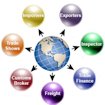Advertisements

Brain Disorders 2015
| Date: | Aug. 24, 2015 - Aug. 26, 2015 |
|---|---|
| Venue: | Crowne Plaza |
| Address: | 19 New Bridge Road,, United Kingdom, EC4V 6DB,, London |
| City, State/Prov.: | |
| Country: |
United Kingdom 
|
Show Details
| No. of Exhibitors: | No. of Attendees: |
|---|
| Floor Size: |
|---|
Trade Show Information
Its our pleasure to welcome you to the International Conference on Brain Disorders and Therapeutics during August 24-26, 2015 at London, UK. The conference will be organized around the theme “Exploring the challenges and recent innovations in prevention, diagnosis and treatment of Brain Disordersâ€. Track 1: Brain Disorders: An Over view
Brain function is described as the global integration of local (segregated) neuronal operations that underlies hierarchical message passing among cortical areas and which is facilitated by hierarchical modular network architectures. There are 10 million people in the UK living with a neurological condition which has a significant impact on their lives. Mainly dementia, stroke, headache, epilepsy and head injury are the neurological conditions suffered in UK. The lifetime risk of developing brain and other central nervous system cancer has been estimated is 1 in 133 for men and 1 in 185 for women in the UK. Various disorders affects the function of Human Brain In this track we will discuss few important topics such as: Fragile X in Adults, Dyslexia and Brain Injuries, Bipolar Disorder, Neurodegenerative Diseases, Mental Health Conditions, Child psychiatric disorders, Schizophrenia, Intracranial Hypertension, Encephalitis, Hydrocephalus, Meningitis, Autism, Sleep disorders and Epilepsy and Multiple Sclerosis.
Track 2: Brain Disorders: Causes, Origin, Genesis and Source
Brain disorders occur when brain is damaged by injury, disease or health conditions. The three brain chemicals noradrenaline, dopamine and serotonin are involved in both bodily functions and brain. Serotonin and Noradrenaline have been consistently linked to psychiatric mood disorders such as bipolar disorder and depression. Dopamine is commonly linked with the pleasure system of the brain. The disruption to the dopamine system is connected to schizophrenia and psychosis which is severe mental disorder characterized by distortions in reality and illogical thought patterns and behaviors. The chemical of brain serotonin is connected to many body functions such as wakefulness, learning, eating, sleep, memory impulsivity, and sexual activity. Researchers believe that abnormal functioning of brain circuits that involve serotonin as a chemical messenger contributes to mood disorders (depression and bipolar disorder). The goal of this session is to understand the Causes, Origin, Genesis and Source of various types of brain disorders. The following are causes of brain disorders: Trauma to the brain, Brain Tumor, Prenatal damage, Substance abuse, inherited conditions that affect the brain, Brain cancer, Brain Infections, Brain’s electrical pathways
Track 3: Brain Disorder Manifestation
A genetic brain disorder is caused by a variation or a mutation in a gene. Genetic brain disorders affect the development and function of the brain. The symptoms of brain disorders typically depend on the cause of the condition. Brain disorders may affect the main areas of your brain that control how we move, think, and behave. Some tumors can constrict the blood vessels in brain. The goal of this session is to understand the Manifestation and Diagnosis of various types of brain disorders.
The following are some common symptoms brain disorders may present: confusion or problems concentrating, headaches or migraines, seizures (convulsions), memory problems, change in the behavior, problems with vision (double vision), lack of muscle control, vomiting or nausea.
Track 4: Pathophysiology of Brain Disorders
Biochemical changes in the brain affect mood and other aspects of mental health. Naturally occurring brain chemicals called neurotransmitters play a role in some brain disorders. In some cases, hormonal imbalances affect mental health.
Pathophysiology of brain disorders depends on Inadequate Nutritional Intake, Impaired Thiamine Utilization, Mechanisms of Brain Injury, Global Cerebral Ischemia, and Pressure on nerve tissue / blood supply may result in permanent damage, Combination of genetic and environmental factors, Loss of directionality of impulse, Serotonergic and neurotransmitter alteration, Neurochemistry and neurophysiology of stress
Track 5: Brain Disorder: Anticipatory Measure and Pervasiveness
The modern noninvasive techniques applied to the human brain allow the mapping of anatomical regions and their interconnecting pathways at near millimeter resolution. The creation of maps of structural or functional connections brings the challenge of extracting relevant or significant aspects of network organization and this challenge can be met by applying modern network modeling and analysis tools. The structural connectivity describes anatomical connections linking a set of neural elements whereas functional connectivity is generally derived from time series observations, and describes patterns of statistical dependence among neural elements. The connectivity pattern is formed by structural links such as synapses or fiber pathways or it represents statistical or causal relationships measured as cross correlations, coherence or information flow. Neural activity and by extension neural codes which are constrained by connectivity. Brain connectivity is thus crucial to elucidating how neurons and neural networks process information.
Diagnostic tests and procedures are vital tools that help physicians confirm or rule out the presence of a neurological disorder or other medical condition. Each year 600,000 people (1% of the UK population) are newly diagnosed with a brain disorders condition. Primary brain tumors represent about 1.6% of all tumors diagnosed in the UK. The aggregate costs of all mental disorders in the United Kingdom are £32 billion.
Imaging tests such as CT— Computed Tomography, MRI— Magnetic Resonance Imaging, Angiography, positron emission tomography (PET— Radionuclide Scanning), and Doppler ultrasonography are commonly used to diagnose neurologic disorders.
Track 6: Associated Disorders
Several complications can occur immediately or soon after a traumatic brain injury. Severe injuries increase the risk of a greater number of complications and more severe complications. Moderate to severe traumatic brain injury results in prolonged or permanent changes in a person's state of consciousness, awareness or responsiveness.
Different states of consciousness include: Coma, Vegetative state, minimally conscious state, Locked-in syndrome, Brain death, Seizures, Fluid buildup, Nerve damage
Severe head injuries cause serious complications. This is mainly because a serious injury can damage the brain, sometimes permanently. Alzheimer's disease damages nerve cells in parts of the brain involved in memory, learning, language, and reasoning. Autism is a neurodevelopmental disorder characterized by impaired social interaction, verbal and non-verbal communication, and restricted and repetitive behavior. Autism appears to result from developmental factors that affect many or all functional brain systems and to disturb the timing of brain development more than the final product. Epilepsy can have both genetic and acquired causes, with interaction of these factors in many cases. Epilepsy may occur as a result of a number of other conditions including tumors, strokes, head trauma, previous infections of the central nervous system, genetic abnormalities, and as a result of brain damage around the time of birth. Parkinson's disease is a degenerative disorder of the central nervous system mainly affecting the motor system. The motor symptoms of Parkinson's disease result from the death of dopamine-generating cells in the substantia nigra, a region of the midbrain. Meningitis is an acute inflammation of the protective membranes covering the brain and spinal cord, known collectively as the meninges. The most common symptoms of meningitis are headache and neck stiffness associated with fever, confusion or altered consciousness, vomiting, and an inability to tolerate light or loud noises.
Exhibitors Information
Attendee Information
Show Contact
| Contact: | Erza Willson | ||
|---|---|---|---|
| Telephone: | 1-650-268-9744 | Fax: |
|
ORGANIZER PROFILE
|
|||
|---|---|---|---|
| City/State | Country: |
United Kingdom 
|
|
| Business Type: | Trade Shows Organizer | Phone Number: | 1-650-268-9744 |
| Fax Number: | Contact Person | Erza Willson |
ORGANIZER PROFILE
City/State/Country -
United Kingdom 

Business Type -
Trade Shows Organizer
Phone Number -
1-650-268-9744
Fax Number -
Contact Person -
Erza Willson



